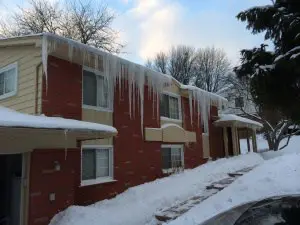Ice dams are masses of ice that lodge at the edge of your roof and block the melting snow from draining off. This occurs because the heat from your attic causes the snow on your roof to melt. But, the edges of your roof are not warmed by the attic’s heat, therefore causing the melted snow to refreeze.
If you do not remove an ice dam, you run the risk of your gutters breaking off, shingles loosening, and water leaking into your home and causing damage—not to mention potentially serious microbial growth within the wall cavities. Additionally, ice dams can cause water to leak into your roof or siding without you even knowing about it! This can cause extensive (and expensive) damage to your home.
The sooner you identify an ice dam, the better chance you have to prevent it from damaging to your home.
How to identify an ice dam:
 Look for large icicles
Look for large icicles
Icicles are the byproduct of melted snow flowing over the ice dam and refreezing. If the icicles are confined solely to the gutters, there may not be water trapped behind them—which is where problems arise. Even if these icicles aren’t putting your home at risk, they are very dangerous and can cause a great deal of harm to people below if they fall. If possible, try to knock them down without standing directly below them. If they are too difficult to remove, request the help of a contractor.
Water running down the house
The problem with ice dams is they block the gutters, preventing the melting snow and ice from draining properly off the roof. Therefore if you have an ice dam, you’ll typically see the overflow of water running down the sides of your house. This can allow water to get behind your siding, potentially causing water damage to the foundation and interior of your home. The blocked water on the roof that doesn’t overflow down the sides of the house can cause the same damage to the roof, attic and interior.
Get a closer view of the roof
Ice dams can’t always be seen from the ground—especially if you have a higher or steeper roof. Not all ice dams are large, therefore making them even harder to spot. Some even form over skylights or in roof pan areas, which are tricky to see. If you can safely do so, get a closer view of the roof to identify ice dams before they can cause damage. If you cannot inspect the roof, or don’t feel comfortable attempting to do so, contact a contractor to identify any potential issues for you.
Related articles:
Is it Okay to Do Roofing in the Winter?




